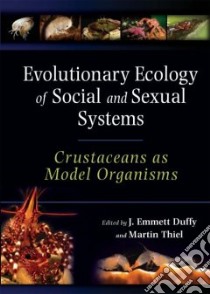Evolutionary Ecology of Social and Sexual Systems - 9780195179927
Un libro in lingua di Duffy J. Emmett (EDT) Thiel Martin (EDT) Leon Marco (ILT) edito da Oxford University Press, 2007
- € 46.90
- Il prezzo è variabile in funzione del cambio della valuta d’origine
Understanding of animal social and sexual evolution has seen a renaissance in recent years with discoveries of frequent infidelity in apparently monogamous species, the importance of sperm competition, active female mate choice, and eusocial behavior in animals outside the traditional social insect groups. Each of these findings has raised new questions, and suggested new answers, about the evolution of behavioral interactions among animals. This volume synthesizes recent research on the sexual and social biology of the Crustacea, one of the dominant invertebrate groups on earth. Its staggering diversity includes ecologically important inhabitants of nearly every environment from deep-sea trenches, through headwater streams, to desert soils. The wide range of crustacean phenotypes and environments is accompanied by a comparable diversity of behavioral and social systems, including the elaborate courtship and wildly exaggerated morphologies of fiddler crabs, the mysterious queuing behavior of migrating spiny lobsters, and even eusociality in coral-reef shrimps. This diversity makes crustaceans particularly valuable for exploring the comparative evolution of sexual and social systems. Despite exciting recent advances, however, general recognition of the value of Crustacea as models has lagged behind that of the better studied insects and vertebrates. This book synthesizes the state of the field in crustacean behavior and sociobiology and places it in a conceptually based, comparative framework that will be valuable to active researchers and students in animal behavior, ecology, and evolutionary biology. It brings together a group of internationally recognized and rising experts in fields related to crustacean behavioral ecology, ranging from physiology and functional morphology, through mating and social behavior, to ecology and phylogeny. Each chapter makes connections to other, non-crustacean taxa, and the volume closes with a summary section that synthesizes the contributions, discusses anthropogenic impacts, highlights unanswered questions, and provides a vision for profitable future research.
Informazioni bibliografiche
- Titolo del Libro in lingua: Evolutionary Ecology of Social and Sexual Systems
- Sottotitolo: Crustaceans As Model Organisms
- Lingua: English
- Autori : Duffy J. Emmett (EDT) Thiel Martin (EDT) Leon Marco (ILT)
- Editore: Oxford University Press
- Collana: Oxford Univ Pr (Hardcover)
- Data di Pubblicazione: 06 Gennaio '07
- Genere: SCIENCE
- Argomenti : Crustacea Behavior Crustacea Sexual behavior Social behavior in animals
- Pagine: 502
- Dimensioni mm: 247 x 165 x 31
- ISBN-10: 0195179927
- EAN-13: 9780195179927


